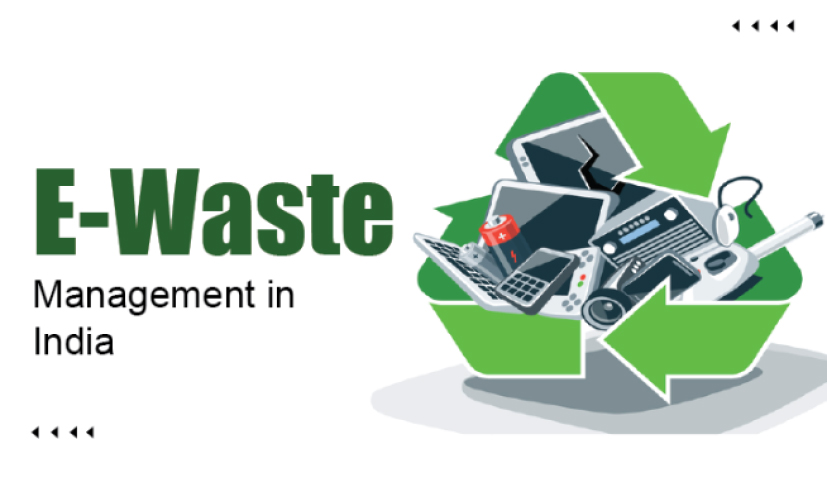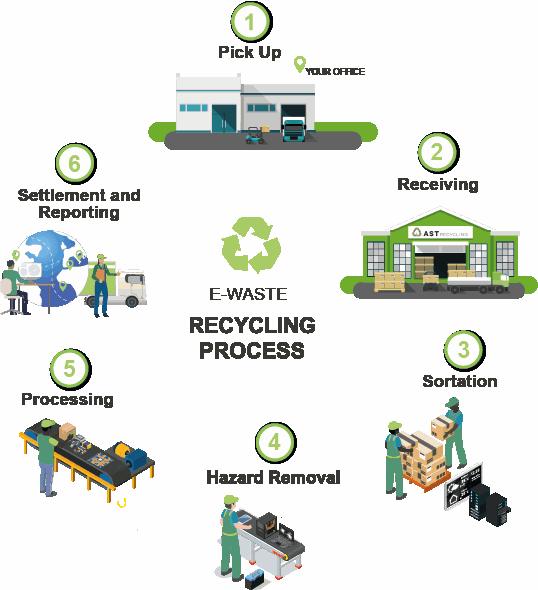India’s digital transformation is unfolding at a rapid pace. With rising smartphone penetration, the spread of internet access, and the government’s push toward digital governance and manufacturing under initiatives like Digital India and Make in India, the country is witnessing a surge in electronic consumption. While this progress strengthens the foundation for Viksit Bharat, it simultaneously generates a growing environmental concern—electronic waste (e-waste).
The Scale of E-Waste in India:
India is now the third-largest generator of e-waste globally, behind China and the United States. According to the Central Pollution Control Board (CPCB), India generated approximately 17.78 lakh metric tonnes of e-waste in 2023–24. This marks a sharp increase from 7.08 lakh metric tonnes in 2017–18—a 151% surge over just six years. On average, the country is adding 1.69 lakh metric tonnes of e-waste every year.
The most significant contributors to e-waste include:
- Consumer electronics and appliances (mobile phones, laptops, TVs, refrigerators)
- IT and telecom equipment
- Industrial automation devices
- Battery-operated and lighting equipment
India’s fast-growing middle class, increasing urbanisation, and rapid obsolescence of technology further accelerate the disposal rate of electronic devices.
Challenges of Informal Recycling and Improper Disposal:
More than 95% of India’s e-waste is processed by the informal sector, often in unsafe and unregulated environments. This informal network, comprising kabadiwalas and local recyclers, uses crude methods like open burning and acid leaching to extract valuable metals such as gold, copper, and palladium. While effective in terms of reach and low operational cost, these methods pose serious threats:
Environmental Hazards:
· Toxic emissions contaminate air, water, and soil.
· Persistent pollutants like lead, mercury, cadmium, and brominated flame retardants enter the food chain, affecting ecosystems.
Health Risks:
· Informal workers, often women and children, suffer from respiratory problems, skin diseases, and chronic illnesses.
· Communities near e-waste clusters report life expectancy as low as 27 years due to continuous exposure to toxins.
Economic Costs:
- India loses ₹80,000 crore annually in precious metals that could be recovered through scientific recycling.
- Water pollution alone causes economic damage of over $10 billion.
- The informal nature of operations leads to an estimated $20 billion loss in tax revenue per year.
Policy Response: Extended Producer Responsibility (EPR):
To address the e-waste challenge, India has implemented the Extended Producer Responsibility (EPR) framework under the E-Waste (Management) Rules, 2022. EPR mandates that producers take responsibility for the lifecycle of electronic products—from design to disposal.
Key Features of the EPR Framework:
- Producers must collect and channel e-waste to authorised recyclers.
- Annual EPR targets are defined based on sales and product lifespans.
- Digital tracking of waste movement is mandatory to improve transparency.
Introduction of Floor Pricing for EPR Certificates:
A key update in 2023 was the implementation of a floor price mechanism for EPR certificates—documents issued to recyclers upon processing e-waste. The floor price guarantees a minimum return for recyclers, encouraging more players to invest in formal recycling operations.
Benefits of Floor Pricing:
- Reduces market volatility in certificate prices.
- Prevents undercutting by unregulated entities.
- Encourages formal sector growth by ensuring recyclers remain economically viable.
- Provides an incentive for producers to source responsibly.
However, there are concerns that this may increase compliance costs for producers, potentially trickling down to consumers. Nevertheless, these costs are marginal when weighed against long-term environmental gains and resource recovery.
The Circular Economy Imperative:
E-waste is not just a challenge—it is also a massive economic opportunity. The shift toward a circular economy can convert this waste into wealth by promoting reuse, repair, remanufacturing, and recycling.
What is a Circular Economy?
Unlike the traditional linear model of "make-use-dispose," a circular economy seeks to:
- Extend the useful life of products.
- Reduce dependence on virgin raw materials.
- Recover valuable resources through closed-loop systems.
The circular model is particularly relevant for India, which faces high raw material import dependency and mounting pressure on natural resources.
International Models and Practices:
- China mandates a minimum use of recycled raw materials in manufacturing.
- The European Union has launched the Right to Repair Directive, promoting repairable designs and accessible spare parts.
India can benefit from adapting these models while tailoring them to its socio-economic context.
Strategies for Building an Effective E-Waste Ecosystem:
To fully realise the potential of circularity, India must address several gaps in policy and infrastructure:
1. Formalising the Informal Sector
· Upskilling informal workers and integrating them into licensed operations.
· Ensuring access to protective equipment and safe recycling technologies.
· Offering financial incentives for registration and compliance.
2. Reverse Logistics and Collection Efficiency
· Create urban collection centres in every district.
· Offer cash-back incentives or discounts to consumers for returning old electronics.
· Partner with e-commerce firms for doorstep pickups of e-waste.
3. Public Awareness and Consumer Behaviour
One of the biggest bottlenecks is consumer inertia. A 2023 ICEA report found that over 200 million unused devices lie idle in Indian homes due to data privacy concerns or lack of knowledge about recycling avenues.
· Launch mass campaigns on data-wiping and secure disposal.
· Promote the benefits of responsible recycling to schools, housing societies, and corporates.
4. Industry Collaboration and Innovation
Industry bodies such as ICEA recommend:
- Establishing regional recycling clusters.
- Developing auditable databases for end-to-end material tracking.
- Incentivising manufacturers to design for modularity, repair, and recyclability.
5. Policy Monitoring and Compliance
- Ensure strict penalties for EPR violations.
- Periodically revise EPR targets based on product lifespan and market dynamics.
- Leverage digital platforms for real-time monitoring of waste flows.
The Strategic Case for E-Waste Management:
As global geopolitics tighten access to rare earth materials and supply chains become vulnerable, India’s ability to recover secondary raw materials will determine its manufacturing resilience. A strong domestic recycling industry will also:
- Reduce strategic import dependencies.
- Boost green job creation, especially for youth and women.
- Contribute to India’s climate goals under the Paris Agreement.
Conclusion:
India’s vision of Viksit Bharat cannot be achieved without a parallel commitment to environmental sustainability. The growing e-waste problem is both a crisis and a strategic opportunity. By implementing robust policies, fostering innovation, and empowering stakeholders—from producers to consumers—India can transform its e-waste into a foundation for a greener, more self-reliant economy. As we move deeper into the digital age, responsible disposal and resource recovery must become core components of national development. The choice before us is clear: either let the mountain of e-waste grow into a liability, or convert it into a circular resource engine that powers the next era of sustainable growth.
| Main question: India is rapidly emerging as a digital economy, but this transformation comes with an environmental cost. Discuss the challenges posed by e-waste in India and suggest strategies for integrating informal recyclers into a formal circular economy framework. |








